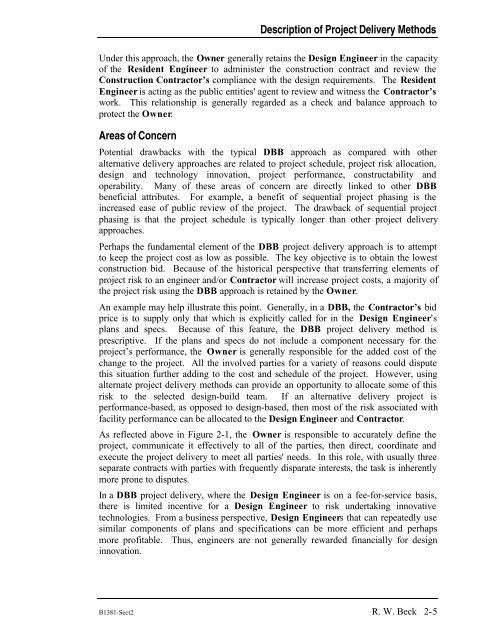Alternative Project Delivery - Texas Water Development Board
Alternative Project Delivery - Texas Water Development Board
Alternative Project Delivery - Texas Water Development Board
Create successful ePaper yourself
Turn your PDF publications into a flip-book with our unique Google optimized e-Paper software.
Description of <strong>Project</strong> <strong>Delivery</strong> Methods<br />
Under this approach, the Owner generally retains the Design Engineer in the capacity<br />
of the Resident Engineer to administer the construction contract and review the<br />
Construction Contractor’s compliance with the design requirements. The Resident<br />
Engineer is acting as the public entities' agent to review and witness the Contractor’s<br />
work. This relationship is generally regarded as a check and balance approach to<br />
protect the Owner.<br />
Areas of Concern<br />
Potential drawbacks with the typical DBB approach as compared with other<br />
alternative delivery approaches are related to project schedule, project risk allocation,<br />
design and technology innovation, project performance, constructability and<br />
operability. Many of these areas of concern are directly linked to other DBB<br />
beneficial attributes. For example, a benefit of sequential project phasing is the<br />
increased ease of public review of the project. The drawback of sequential project<br />
phasing is that the project schedule is typically longer than other project delivery<br />
approaches.<br />
Perhaps the fundamental element of the DBB project delivery approach is to attempt<br />
to keep the project cost as low as possible. The key objective is to obtain the lowest<br />
construction bid. Because of the historical perspective that transferring elements of<br />
project risk to an engineer and/or Contractor will increase project costs, a majority of<br />
the project risk using the DBB approach is retained by the Owner.<br />
An example may help illustrate this point. Generally, in a DBB, the Contractor’s bid<br />
price is to supply only that which is explicitly called for in the Design Engineer’s<br />
plans and specs. Because of this feature, the DBB project delivery method is<br />
prescriptive. If the plans and specs do not include a component necessary for the<br />
project’s performance, the Owner is generally responsible for the added cost of the<br />
change to the project. All the involved parties for a variety of reasons could dispute<br />
this situation further adding to the cost and schedule of the project. However, using<br />
alternate project delivery methods can provide an opportunity to allocate some of this<br />
risk to the selected design-build team. If an alternative delivery project is<br />
performance-based, as opposed to design-based, then most of the risk associated with<br />
facility performance can be allocated to the Design Engineer and Contractor.<br />
As reflected above in Figure 2-1, the Owner is responsible to accurately define the<br />
project, communicate it effectively to all of the parties, then direct, coordinate and<br />
execute the project delivery to meet all parties' needs. In this role, with usually three<br />
separate contracts with parties with frequently disparate interests, the task is inherently<br />
more prone to disputes.<br />
In a DBB project delivery, where the Design Engineer is on a fee-for-service basis,<br />
there is limited incentive for a Design Engineer to risk undertaking innovative<br />
technologies. From a business perspective, Design Engineers that can repeatedly use<br />
similar components of plans and specifications can be more efficient and perhaps<br />
more profitable. Thus, engineers are not generally rewarded financially for design<br />
innovation.<br />
B1381-Sect2 R. W. Beck 2-5
















